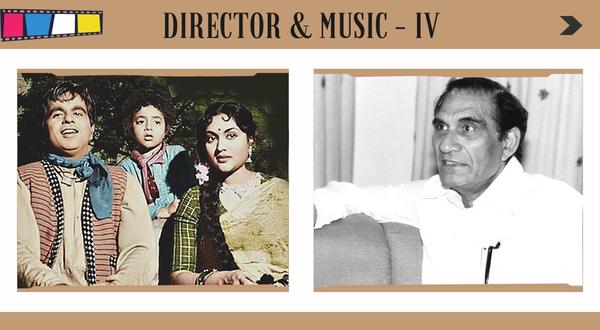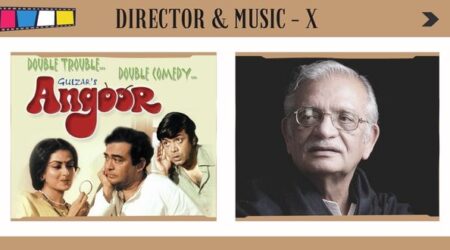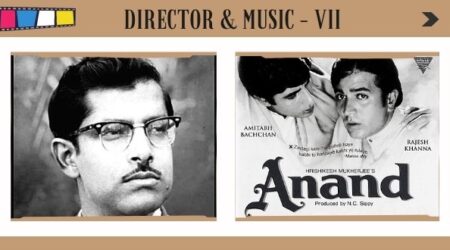Insaan Ki Aulaad Hai Insaan Banega – BR Chopra
“Tu Hindu Banega Na Musalman banega, insaan ki aulaad hai insaan banega…” The song is from the film Dhool ka Phool’ 1959 which was not directed by B R Chopra but by his equally illustrious brother Yash Chopra. B R Chopra (hereafter referred to as B R in this article) produced Dhool ka Phool and 50 other films and TV series under his banner B R Films, of which he directed 24.
While it may look as if only 24 were directed by him, his role as a producer can’t be overlooked which gave him complete control over the overall look and feel of the film. However, be the quality of the film, the music was always important for this producer-director whose banner B R Films became legendary after acquiring a new generation of fans in the 1990s with his TV Series ‘Mahabharat’.
In spite of his overtly “commercial” sensibilities with the films being loaded with songs, dances, dialogues, courtroom scenes, most of BR’s films addressed some contemporary issue or the other, often challenging then-held orthodoxy. The underlying humanity in his films is best depicted in the film ‘Dhool ka Phool’ about an orphan being adopted by a Muslim man and teaching him Tu Hindu banega na Musalman banega, Insaan ki aulaad hai insaan banega.
 Born in 1914 and educated in pre-partition Lahore, BR’s career as a film journalist came to a halt due to Partition. Shifting to Bombay (now Mumbai), BR’s initial career was full of struggles. His first film as a director Afsana’1951 was a hit. Soon B R Films was established and started a long and illustrious path of well-crafted films that tackled some social issue or the other.
Born in 1914 and educated in pre-partition Lahore, BR’s career as a film journalist came to a halt due to Partition. Shifting to Bombay (now Mumbai), BR’s initial career was full of struggles. His first film as a director Afsana’1951 was a hit. Soon B R Films was established and started a long and illustrious path of well-crafted films that tackled some social issue or the other.
With the path-breaking Naya Daur 1957, a truly new age began in film making with films geared to the then-emerging reality of serving not only as entertainers but also as a message to the populace – that of serving India in one way or the other. ‘Naya Daur’ gave the message that the old (horse carriages) and the new (motorized carriages – the bus) could co-exist in the modern age and each had its place in the current social setup.
‘Naya Daur’ had hit songs that are popular, with the new generation, thanks to its re-release in a colorized version in 2007. The songs are seamlessly integrated into the structure of the film. The best of these is “Saathi Haath Badhana” when the villagers decide to join hands and build the road and the bridge that will help the protagonist Shankar win the horse carriage vs bus race! The villagers are fired up and take pride in their ability to do hard manual labor. The word “Saathi” can be translated as “Comrade”, thus confirming the overall socialist ethos behind Sahir Ludhianvi’s lyrics (and similar sentiments in many films of the 1950s).
The entry of a “city reporter”, inspired by the events in the village, provides some scope for some light comic relief. When the villagers ask the man why he has come to the village the man replies that the world should get inspired by this event and he will be the one who will write articles in a string of newspapers. The cynical villagers ask him whether he is a “laat saheb, Patel, Governor or who else”, the song “Mai Bambai ka Babu” starts with Mohammed Rafi using his “special voice” for Johnny Walker.
The other songs like “Ye desh hai veer jawanon ka”, “Aana hai to aa raahe mein”, “Maang ke saath tumhara”, “Reshmi salwar kurta jaali ka” all point to OPN’s prowess in being at home in any genre which too has been integrated into the film without disturbing the pace.
The generation of filmmakers who faced the pains of Partition either stayed away from it as a taboo topic or questioned it half-heartedly. Partition films were conspicuous by their absence until BR produced “Dharm Putra”, directed by Yash. A lesser-known song penned by Sahir Ludhianvi talks about the path one takes to realize God. Some qawwali singers in a mosque sing “Ye masjid hai who buthkhaana; Chahey ye maano chahey woh maano”.
Later when the Partition riots break out, a song suddenly starts. One would think that this is a regular interruption but the lyrics sear one’s soul when the singer – Rajendra Kumar in a special appearance – asks “Ye kiska lahoo hai kaun mara”
Sadhana’1958 took a penetrative look at how society treats a fallen woman – and women in general – when Sahir questions everyone about the differences in perception in what men do and how women endure. The lyrics are timeless and valid even today when Lata Mangeshkar sings “Aurat ne janam diya mardon ko, mardon ne usey baazar diya, Jab jee chaha maslaa kuchlaa, jab jee chaha dutkaar diya”. Very bold for its time, the film questioned the attitudes towards rehabilitation of prostitutes and women.
Most BR Films had a courtroom scene somewhere or the other – usually in the film’s climax. Kanoon’1960 was a complete departure for a B R Production in that it didn’t have a single song and depended on the musical genius of Salil Choudhury to create the background music. Almost half the film was set in court, leading to long courtroom scenes. However, the ambiance was enhanced by Salil Choudhury’s music that fused well with the on-screen happenings.

Gumrah’1963 broke new ground in showing a woman caught between a former lover and her husband, who she married because of some circumstances (once again by today’s standards, the reasons may look lame). Her secret meetings with her lover torment her and his plea to her is to start afresh with “Chalo ek baar phir se ajnabi ban jaaye hum donon”. The lyrics end with the entreaty to forget the past and even kill the relationship and leave it at a beautiful stage. “woh afsana jisey anjaam tak laana na ho mumkin, Usey ek khoobsurat mod de kar chhodna achha”
In 1965, B.R. produced the first of its kind multi-starrer ‘Waqt’ with brother director Yash as the director. Lost and found brothers, rich-poor divide, crime, punishment – all were fused in this colorful musical extravaganza to become a super hit. The film had the unusual tribute to living the moment, which has now become timeless, and even an anthem with the 21st-century generation. Aagey bhi jaane na tu, peeche bhi jaane na tu, Jo bhi hai, bas yahi ek pal hai
‘Humraaz’1967 was a thriller with a difference in that it had two heroes and two heroines and a murder mystery woven around its core. The songs however were super hits contributing to the film’s success. In music director Ravi, (born Ravi Shankar Sharma), B.R. had found the perfect synergy with his cinematic vision and simple hummable melodies. ‘Kisi Patthar ki moorat se, mohabbat ka iraada hai´, ‘Na muh chhupa ke jiyo, aur na sar jhuka ke jiyo”, “Hey neele gagan ke tale”, “Dil karta O yara dildara” matched the onscreen visuals perfectly with Mahendra Kapoor ranging from entreaties, full-throated roars, sarcasm – no doubt helped by Sahir Ludhianvi’s lyrics, who had become a “house composer” for BR Films.
‘Aadmi aur Insaan’1969 was one of the earliest movies to show corruption and the clash between profits and conscience. While there is a backstory why this happens, the fact that someone of the stature of BR with Yash again as the director, addressed the topic, proved that the Chopra brothers knew what contemporary depictions clicked with the audience and what was the perfect balance between entertainment and a social message. In this case, the taunting challenge by Mumtaz to Dharmendra about staying true to his values is shown on screen by the song “Zindagi ittefaq hai”
As coincidence would have it, the brother’s next project was a “quickie” – yet another songless film made in a month. The then-emerging superstar Rajesh Khanna proved that he could act – without crinkling his eyes and smiling his famous smile. ‘Ittefaq’1969 was also the last collaboration between the brothers as Yash Chopra moved on to form Yash Raj films and create his unique style of fluffy romances (more on that in the next issue).
‘Dastaan’1972 was a rambling story of a man taking on the identity of a double and then discovering his past and his present. The film didn’t run and even Dilip Kumar’s presence couldn’t help it from being an average run at the box office. Next, BR went back to one of his staples, the crime thriller, which would – inevitably – have a lengthy courtroom scene. ‘Dhund’1973 was a hit due to many reasons but primarily showcasing new emerging talents in Zeenat Aman and Danny Denzongpa as her sadistic crippled wheelchair-bound husband. Caught between a sympathetic local lawyer-cum-politician and her sadistic husband, the woman Rani sings about her dilemma. “Uljhan suljhey na, Rasta soojhey na, Jaaon kahaan main.
‘Karm’1977 was a miserable flop. Somehow Rajesh Khanna and BR Films just didn’t click. However, BR showed his versatility with the rollicking comedy ‘Pati, Patni aur Who’1978. The light-hearted look at a man with a “roving eye” that stopped short of full-fledged infidelity, was a big hit! Only a Sanjeev Kumar could have carried off a “Thande thande paani se nahaana chaahiye”
 ‘Insaaf ka Tarazu’1980 was BR’s last serious “social message” film where it questioned the treatment of rape victims and how they were treated unsympathetically by courts. The songs were nothing to write about as the film was more about the model raped by a wealthy man and her continuing search for justice while the rich man and his lawyer taunted the law. Dr. Shreeram Lagoo, usually given to sober sympathetic roles, was excellent as the seedy lawyer who saves the wealthy man, by twisting the facts.
‘Insaaf ka Tarazu’1980 was BR’s last serious “social message” film where it questioned the treatment of rape victims and how they were treated unsympathetically by courts. The songs were nothing to write about as the film was more about the model raped by a wealthy man and her continuing search for justice while the rich man and his lawyer taunted the law. Dr. Shreeram Lagoo, usually given to sober sympathetic roles, was excellent as the seedy lawyer who saves the wealthy man, by twisting the facts.
‘Awam’1987 was the last hurrah, to adapt to the changing trend of violent films in the 1980s. The story was about patriotism and treachery, which somehow became a hit. Yet there are hardly any memorable songs from the film.
With the 1980s, the audience taste didn’t quite match what BR Films churned out – till the advent of the ‘Mahabharat’ TV series which once again saw BR emerging as a master filmmaker, bringing his considerable filmmaking talents to the fast-paced medium of TV.
BR’s contribution remains unparalleled in making socially relevant films. He kept within the regular “Bollywood” commercial angle with songs, speeches, dances, etc yet addressed some vital core issues BR had passed the baton of direction to his son Ravi Chopra. The latter directed many successful films, among which ‘Baghbaan’2003 was a tribute by Ravi to his parent (and parents everywhere). BR passed away in 2008 while his son Ravi passed away first in 2014. BR Chopra set a personal stamp on Indian films and the banner that bears his name continues the good work even today.
BR Chopra’s output as Director is listed below: (includes TV Series)
- 1951 Afsana
- 1954 Chandni Chowk
- 1956 Ek-Hi-Rasta
- 1957 Naya Daur
- 1958 Sadhana
- 1960 Kanoon (Songless)
- 1963 Gumrah
- 1967 Hamraaz
- 1972 Dastaan
- 1973 Dhund
- 1977 Karm
- 1978 Pati Patni Aur Woh
- 1980 Insaf Ka Tarazu
- 1982 Nikaah
- 1985 Tawaif
- 1986 Bahadur Shah Zafar (TV Series)
- 1987 Avam
- 1988-1990 Mahabharat (TV Series) (94 episodes)
- 1992 Kal Ki Awaz
- 1992 Sauda (TV Series)
- 1993-1996 Kanoon (TV Series) (111 episodes)














Comment (1)
Good